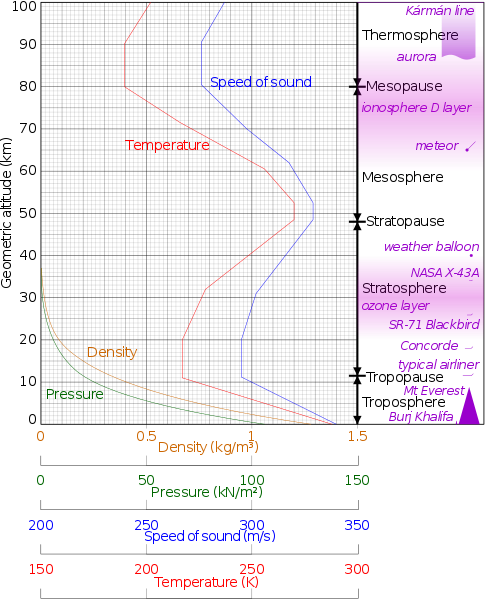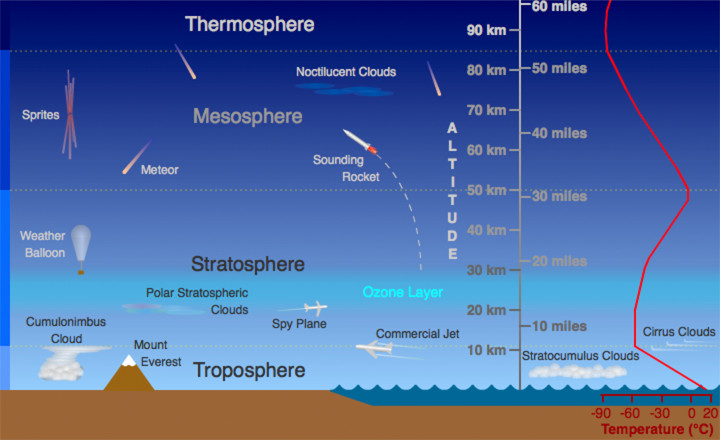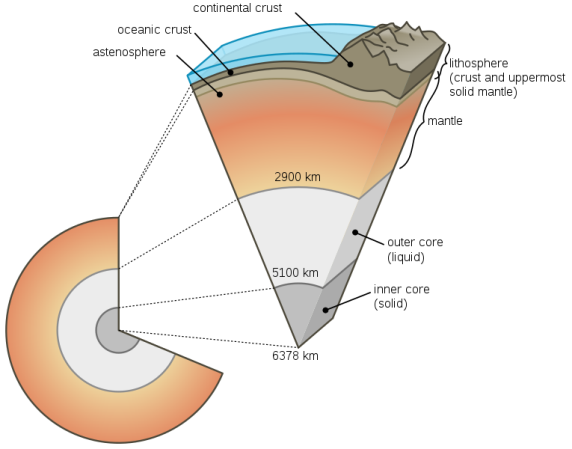Main Body
Chapter 4
Topic 4 – Earth from Top-Down
Although the Critical Zone focuses on the atmosphere just above the Earth’s surface down to the initial few metres of the Earth’s crust, the systems at work supporting the Critical Zone extend much further out into space and down beneath our feet. The atmosphere and internal structure of the Earth are similar in that both are composed of several distinct layers of material. As far as Earth Systems, we usually define these layers based on their composition and function. The atmosphere is comprised of a few main gases:
- Nitrogen (N2 –> ~78%)
- Oxygen (O2 –> ~21%)
- Argon (Ar –> ~0.93%)
- Carbon Dioxide (CO2 –> ~0.04%)
- other trace gases (including methane (CH4), water vapour (H2O), ozone (O3) and more).
Nitrogen and Oxygen are mixed in a nearly constant ratio throughout the lower atmosphere (also known as the Homosphere, ~0-80 km), and are known as ‘permanent’ gases whereas the other gases vary in their amounts in the lower atmosphere across the Earth, and are known as ‘variable’ gases. Above the Homosphere, in the Heterosphere (>80 km), gases separate out based on density. There are three key relationships to remember with respect to atmospheric composition and gases:
As one moves up through the atmosphere:
1. Air density decreases
2. Atmospheric pressure decreases
3. Atmospheric heat decreases
The rate at which change occurs through the atmosphere for density, pressure, temperature and heat are referred to as lapse rates. For example, the average lapse rate for temperature in the lowest part of the atmosphere is 6.4°C/km.

Within the Homosphere, There are three distinct sub-layers of the atmosphere that vary based on temperature and function:
- 0-17 km – Troposphere – average temperature decreases from 15°C at the base to -57°C at the top. Where most clouds form and atmosphere/hydrosphere/lithosphere interaction takes place.
- 17-48 km – Stratosphere- average temperature increases from -57°C at the base to 0°C at the top. High concentrations of ozone in this layer absorb significant ultraviolet radiation from the Sun.
- 48-80 km – Mesosphere – average temperature decreases from 0°C at the base to -90°C at the top. Coldest part of the atmosphere in measured temperature.
In the Heterosphere, a final sub-layer of the atmosphere exists:
- >80 km – Thermosphere – average temperature increase from -90 at the base to 1200°C at the top. The thermosphere has a high temperature due to direct interaction with intense solar radiation at its upper surface, but the air particles are extremely low density here, so the felt heat is very low.*

*Recall, temperature is a measure of average kinetic energy, whereas heat is a measure of thermal energy transfer from one system to another. Where particle density is low, the transfer of heat energy is inefficient.
The Earth’s interior:
Below the atmosphere lies Earth’s lithosphere, or rocky surface. Our current understanding of Earth’s internal structure is based on several relatively recent discoveries and the behaviour of seismic waves as they travel through the Earth to map out layers of density in the Earth’s interior. The Earth’s interior can be defined as having four distinct zones:
- Surface to 70 km depth – Lithospheric crust – Rigid, rocky outer surface of the Earth. Coolest zone of Earth’s interior. Where tectonic plates exist and interact.
- 70 km to 2900 km depth – Mantle – Rigid to plastic material, which provides the driving mechanisms for plate tectonics.
- 2900 km to 5150 km depth – Outer core – Molten mineral material, mostly iron. Very high temperatures keep the material liquid.
- 5150 km to 6370 km depth – Inner core – Solid mineral material, mostly iron. Though temperatures are higher than the melting point of iron, it remains a solid because of the exceedingly high pressure imposed by the surrounding layers.
The mantle is the most complex of these zones. Where it contacts the lithospheric crust at the Mohorovicic discontinuity (also known as the ‘moho’), it is rocky and rigid, but immediately below this zone it transitions into a plastic layer called the Asthenosphere, the hottest part of the mantle. Although not fully liquid, the plastic Asthenosphere allows for mobility, through convection currents driven by heat from radioactive decay of elements within the Earth’s core. This mobility allows for the movement of overriding tectonic plates. Below the Asthenosphere, there is a transition to the upper mantle and then below that into the lower mantle, two layers distinguished by mineral composition and slight differences in mobility (the lower mantle is under higher pressures and deforms slowly over long time periods).

There are two main types of crust that make up the lithosphere.
Oceanic crust:
- Geography: underlies most of the world’s ocean water.
- Mineral composition: mainly silica, magnesium and iron, combined in a rock called Basalt.
- Average density: 3.0 g/cm3.
Continental crust:
- Geography: comprises most of the world’s land area.
- Mineral composition: primarily silica and aluminum.
- Average density: 2.7 g/cm3.
As a result of their different density, when oceanic and continental crust meet at boundaries in the Earth’s lithosphere, oceanic crust normally sinks below the continental crust.
The density of air or atmospheric density, denoted p, is the mass per unit volume of Earth's atmosphere (Wiki)
Density is defined as the ratio between mass and volume or mass per unit volume (Study.com)
It is the force exerted on a surface by the air above it as gravity pulls it to Earth (NatGeo)
The definition of air pressure is the force exerted onto a surface by the weight of the air (YourDictionary)
Is defined as the force acting on a surface from another mass per unit area (PhysGeography.net)
Heat is defined as energy in the process of being transferred from one object to another because of the temperature difference between them. In the atmosphere, heat is commonly transferred by conduction, convection, advection, and radiation (PhysGeography.net)
the rates at which air temperature decreases with altitude (Itseducationglossary)
is a measure of the intensity or degree of hotness in a body. Technically, it is determined by getting the average speed of a body's molecules (PhysGeography.net)
Temperature is the degree of hotness or coldness of the atmosphere on some chosen scale. It is commonly measured in Celsius or Fahrenheit (Wikibooks)
Is the solid inorganic portion of the Earth (composed of rocks, minerals, and elements) (PhysGeo.net)
the crust and upper mantle. Either solid or highly viscous, this layer is not easily deformed or manipulated (itseducation)
stiff and unflexible; not pliant or flexible; firmly set. (Vocabulary.com)
Theory suggesting that the Earth's surface is composed of a number of oceanic and continental plates. Driven by convection currents in the mantle, these plates have the ability to slowly move across the Earth's plastic asthenosphere. (PhysGeo.net)
ability of certain solids to flow or to change shape permanently when subjected to stresses of intermediate magnitude between those producing temporary deformation (Britannica)
object that's reduced to liquid form by heating
rock that has been transformed into liquid form by being heated
The lower boundary of the crust. At this boundary seismic wave velocities show an increase in speed as they enter the upper mantle (PhysGeo.net)
is the boundary between the crust and the mantle (Geology.com)
Zone in the Earth's mantle that exhibits plastic properties. Located below the lithosphere (PhysGeo.net)
naturally occurring inorganic solids with a definite chemical composition, and an ordered internal structure (Geology.com) **ordered regular repeating structure
A naturally occurring inorganic solid with a crystalline structure and a specific chemical composition (PhysGeo.net)
